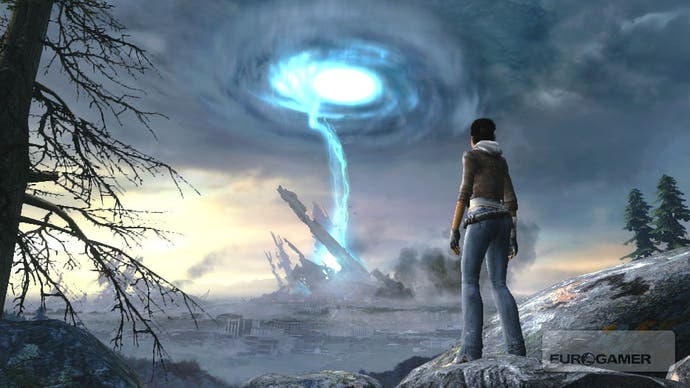Half-Life 2: Episode Two
What next in the parade of constant obstacles?
Over the past ten or more years, Valve has crafted and invested so much into creating this believable world, with this rich back-story and quality cast that it's now become every bit as important as the gameplay you're wrapped up in. As a fan of the series, if you've played through Half-Life, Opposing Force, Blue Shift, and both previous parts of Half-Life 2, you've unwittingly built up a conscious knowledge of where everyone fits in to a story that never strays into nerdy territory. If anything the inherent gameplay familiarity means Episode Two's storyline is now pushed front and centre when you're running through the six chapters. You care what happens. It matters. You don't mind that you're shooting the same guns, or nailing the same enemies. In a genre where the storyline can often feel like a tacked-on afterthought to link together some maps, Valve's ability to frame the action with such subtle cinematic panache is still leading the way in interactive storytelling, so it's important to emphasis what Episode Two really represents to its fans.
Our Mutual Fiend
You could also justifiably interpret all of this as making excuses for Valve churning out more of the same, but that's definitely not the case. Broken down into a series of mini, linear combat encounters (which is, after all, what most of the gameplay boils down to), it's hard not to admire that, either. Each set-piece, whether you're duking it out in a narrow corridor or caning it across a wide expanse with a gunship in hot pursuit, feels like Valve sat down on every single occasion and asked themselves "is this fun?" There's barely a single moment in the entire game where you'll feel bored, unchallenged or maddeningly overstreched. It's pitched perfect right the way through, always testing you - sometimes to the limit - but never stacking things up so as to feel unfair or outside of you capabilities.

It's also important to stress that Episode Two does introduce new enemies, hugely varied environments and, eventually, new gameplay elements when the time is right - and all feel in-keeping with what you'd expect from Valve. First up, you'll encounter the projectile-vomiting Acid Antlions, which come armed with a devastatingly accurate attack that keeps you pinned down, desperately waiting for the right moment to poke out and return a few well-placed grenades.
And just when you might suspect familiarity might be creeping back in, you're sent down some sort of bio-organic nest, deep in the bowels of the Earth on a daring raid to retrieve an egg sample. Not only does it contrast hugely with any Half-Life environment since, perhaps, Xen, you'll feel positively slimy running through its inter-weaving tunnel complex. From underground mine shafts and lift-repair puzzles, you'll escape the claustrophobic netherworld to the complete opposite. On a mission to retrieve a working vehicle, suddenly you'll feel liberated and enjoy the wind in your hair. But learning the lessons of the past, such sections never outstay their welcome, as each chapter clocks in at about an hour. If Valve had have felt particularly brave, it could have easily released each individual chapter at monthly intervals and, bingo, episodic gaming. Such is the density of entertainment and contrast between each segment, it would have worked, too.
Under The Radar

The last chapter, in particular, sees Valve really upping the ante, saving some of the best ideas it has ever had for a monumental climax that's as brutally entertaining as any first-person shooter level you'll have come across. Frantic, testing, and jaw droppingly well-choreographed, it's knife-edge stuff as you're tested to the absolute limit in an against-the-odds, all-or-nothing fight to the death. Perversely scripted, it continually fools you into thinking you're nearly there....before unleashing another, even more testing wave upon you. Again, without wishing to spoil the surprise element, the hub-like level structure offers a refreshing degree of freedom to develop your own strategy in the fight against the united efforts of the Combine forces. And then, just when you think the whole thing's over, it unleashes probably the best climax that the series has offered to date. So many unanswered questions...what a cliffhanger. This is clearly what episodic gaming needs to do - leave you desperate for more and yet fully sated for the time being.
Hopefully we won't have that much longer to wait for Episode Three. In what's now set-up to be an incredible climax to a truly landmark sequence of releases from Valve, Episode Two leaves us in no doubt that is Valve back to its very best, feeling like a happy medium between the mind-blowing excess of its parent game and its somewhat compact Episode One offspring. While initially lacking in gameplay novelty or many truly 'new' elements that fans always hanker for, it more than makes up for this with its consistently engaging narrative tricks, refined set-pieces and a staggering climax. Even as a standalone release at full price, you'd be hard-pressed to give Episode Two less than a 9, but within the confines of the incredible value Orange Box, it's simply an essential game that any shooter fan needs to play - but from start to finish this time please...
